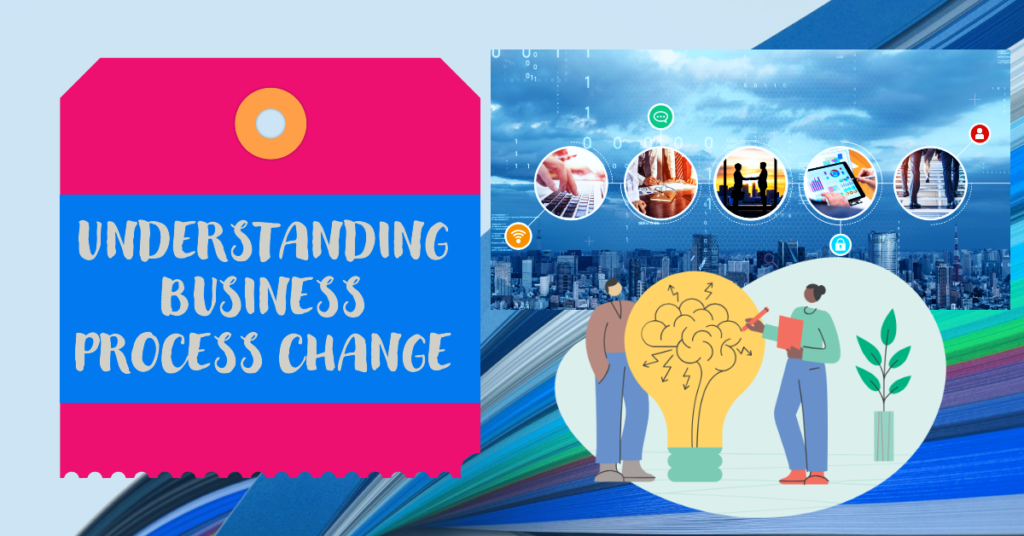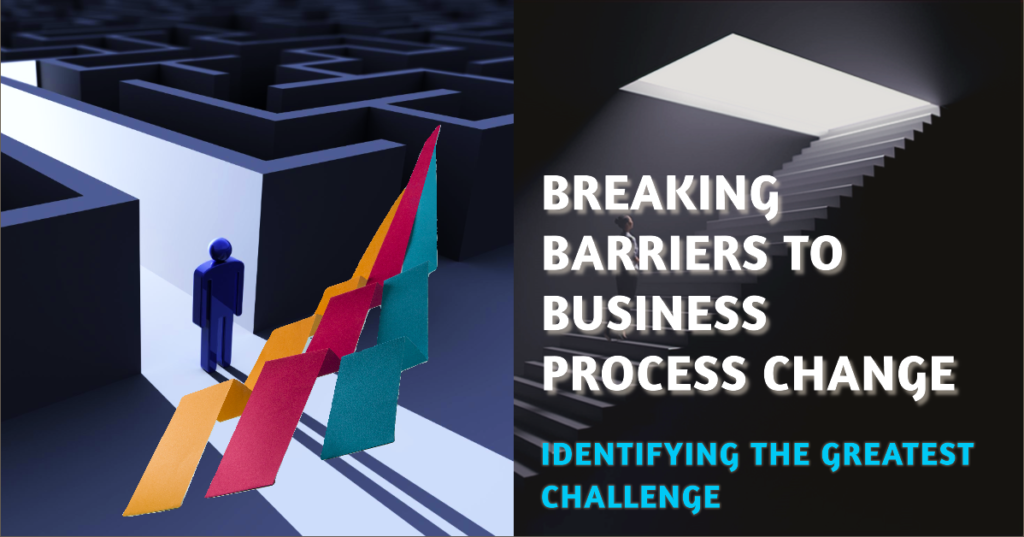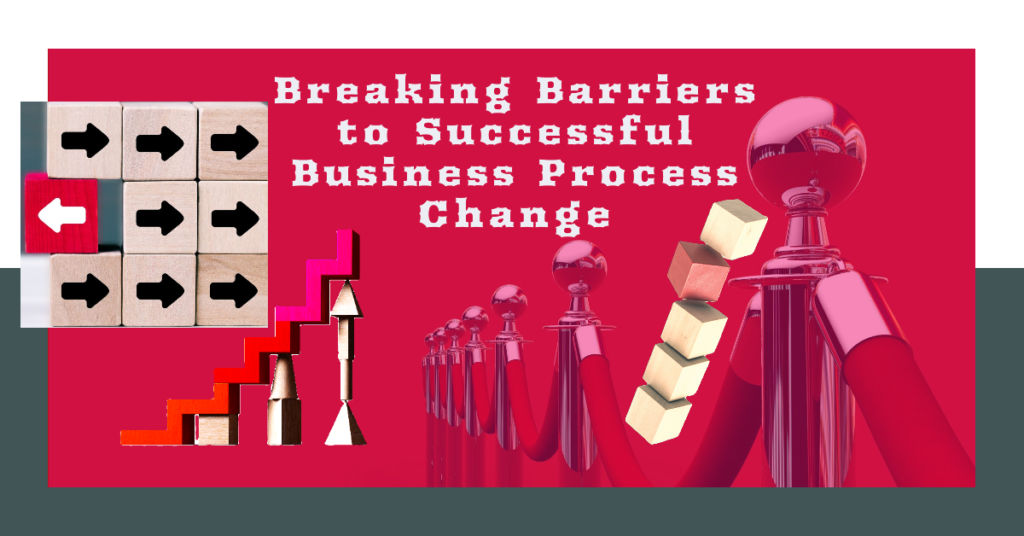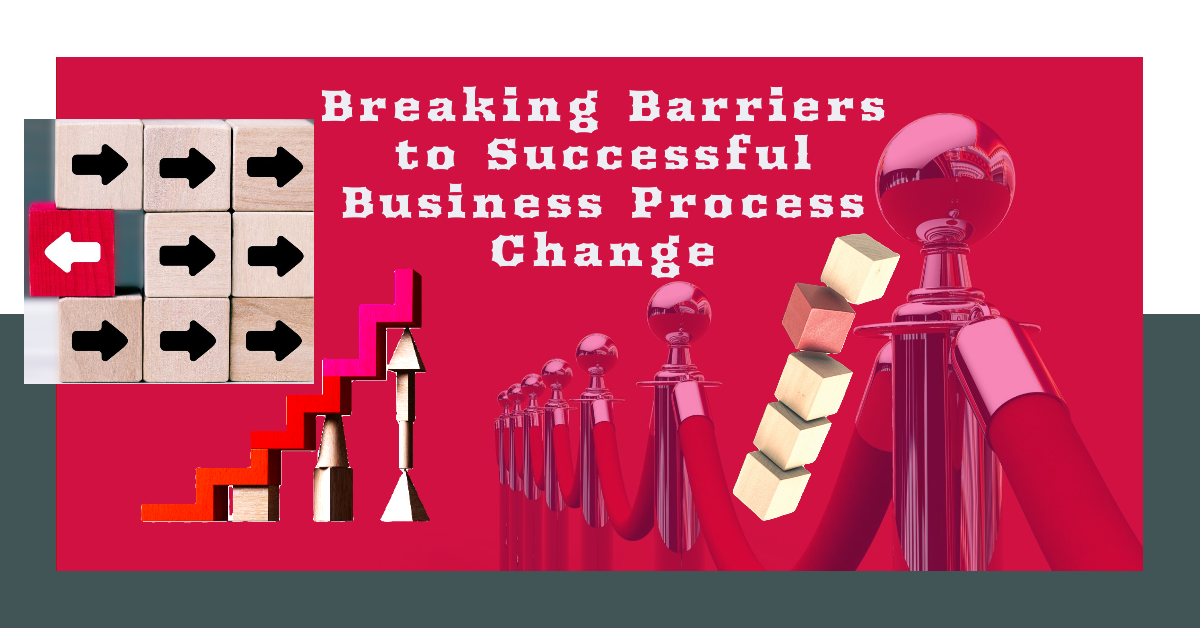
In today’s competitive environment, achieving successful business process change is crucial. It’s the cornerstone for organizational agility and sustained success. However, enacting successful business process change is notoriously difficult, with reported failure rates as high as 70%. These obstacles, whether internal or external, can significantly impede organizational change. Research shows that resistance to change is the number one obstacle derailing organizational change efforts. One question that often arises in this context is, “What is the Greatest Barrier to Successful Business Process Change?”
This article aims to explore this query, shedding light on the multitude of barriers that exist. We will delve deep into aspects like organizational culture, management challenges, and employee buy-in. Our focus will be on identifying the most formidable barrier and providing insights to overcome change effectively. Join us as we navigate through the intricate landscape of business process transformation, offering a comprehensive view of the challenges and solutions in implementing successful change initiatives.
Understanding Business Process Change

What is Business Process Change?
Business Process Change is the strategic transformation of an organization’s existing processes, aiming to optimize performance and adapt to evolving business objectives. It involves:
- Adoption of innovative methodologies and technologies.
- Restructuring to improve efficiency and productivity.
- Alignment with market demands and customer needs.
Why is Business Process Change Important?
- Competitive Advantage: It enables organizations to stay ahead in the market by adopting best practices and innovative solutions.
- Enhanced Efficiency: Streamlines operations to reduce bottlenecks and lower costs.
- Increased Agility: Allows quick adaptation to market shifts and accelerates response to opportunities.
- Customer Satisfaction: Aligning processes with customer needs ensures enhanced satisfaction and loyalty.
- Operational Efficiency: Streamlining and optimizing processes leads to reduced costs and improved productivity.
- Risk Mitigation: Helps in identifying and addressing potential risks proactively. Proactive adaptation helps mitigate potential risks and address management challenges effectively.
The Role of Optimization and Automation in Enhancing Business Processes
Optimization and automation are integral in business process change, enabling organizations to:
- Streamline workflows, eliminating redundancies and inefficiencies.
- Enhance Productivity: By automating repetitive tasks, allowing focus on strategic activities.
- Reduce Errors: Through precise, automated actions, ensuring accuracy.
- Adapt Quickly: To change market conditions and customer expectations.
What is the Greatest Barrier to Successful Business Process Change?
Identifying the greatest barrier is pivotal for successful business process change. Often, the organizational culture and inherent resistance to change emerge as substantial obstacles. This resistance stems from a lack of clear objectives, insufficient leadership support, and employees’ reluctance to embrace new systems and change initiatives. Overcoming this barrier is essential for ensuring the successful implementation and adoption of change, leading to improved business outcomes and sustained organizational growth.
What is Organizational Culture?
Organizational culture is the collective values, beliefs, assumptions, and behaviors that influence how individuals within a company think, feel, and act. It reflects unwritten rules, mindsets, customs, and behavioral norms that have developed over time and become entrenched. Key components include:
- Shared Assumptions: Ingrained beliefs about how things are done
- Common Values: Guiding principles that dictate priorities
- Normalized Behaviors: Accepted practices and unspoken standards of conduct
- Established Rituals: Routines, ceremonies, and everyday interactions
- Physical Environment: Office layout, decor that reinforces a culture
Organizational culture manifests through the collective behaviors and attitudes perpetuated by an organization’s members. It wields immense influence over nearly all aspects of operations and change.
How does Organizational Culture Impact Business Process Change?
- Acts as either an enabler or barrier to change initiatives
- Long-entrenched cultures resist disruption to deep-rooted norms
- Misalignment between existing vs. needed culture undermines change
- Cultural traits like flexibility/agility facilitate change adoption
- High-risk cultures impede innovation and process improvements
- Lack of collaboration hinders execution across siloed units
- Change causes uncertainty/discomfort in stable, set cultures
- New initiatives conflict with unspoken cultural rules and rituals
- Employees revert to old ways that align with the prevailing culture
Examples of How Organizational Culture Can Hinder Business Process Change
- Inflexibility and Resistance: A culture resistant to adaptation and innovation can hinder the acceptance of new information systems and software tools, leading to stagnation.
- Poor Communication: A culture that doesn’t prioritize open dialogue can result in misunderstandings and lack of clarity during change processes, affecting the implementation of change initiatives.
- Lack of Employee Engagement: A culture that doesn’t value employee input can lead to a lack of employee buy-in and support, derailing change management strategies.
How to Overcome Organizational Culture Barriers to Business Process Change
Overcoming cultural barriers requires a multifaceted approach. Engagement and transparency are pivotal, ensuring every stakeholder understands the change process. Training and inclusive decision-making are crucial, fostering buy-in and employee productivity. Constant communication and feedback loops are essential to address concerns and refine the change management strategy, ensuring successful change initiatives. For a quick response, you need:
- Assess and understand current organizational culture through surveys and discussions
- Identify mismatches between current culture and needed culture
- Communicate desired changes and obtain employee input into redesigns
- Encourage collaboration, flexibility, and experimentation norms
- Reinforce changes through training programs, storytelling, and leading by example
- Recognize and reward demonstrations of desired cultural traits
- Be patient – and evolving culture requires persistence over an extended timeframe
- Don’t force change – culture shifts through organic adoption and alignment with formal structures
- Leverage influencers within the culture as change champions
Identifying Barriers to Change

Organizational Culture
Organizational culture refers to the collective behaviors, assumptions, values, and norms that dictate “how things are done” in a company. It develops gradually over time as employees interact and shared experiences create common perspectives. An organization’s culture manifests through its symbols, language, decision-making, policies, physical space, and shared stories.
Once firmly rooted, an organization’s culture wields immense influence over nearly all aspects of operations. The greatest barrier to successful business process change is long-entrenched cultures actively resisting efforts to disrupt the status quo. A culture characterized by stability, predictability, and risk aversion will perceive change as highly threatening. On the other hand, cultures embracing flexibility, collaboration, and innovation enable smoother adoption of change. A misalignment between an organization’s existing culture and the culture needed to successfully implement a process change acts as a significant barrier.
- Shared assumptions and ingrained norms resist disruption of the status quo
- Misalignment between existing and needed cultural traits impedes change
- Lack of collaboration, flexibility, and openness to experimentation hinders new initiatives
- Change causes discomfort as it conflicts with stable, entrenched cultural rituals
Strategies to overcome:
- Assess current culture and identify mismatches
- Communicate changes and obtain employee input
- Encourage desired norms like collaboration and initiative
- Reinforce changes through training, storytelling, incentives
- Leverage culture carriers to champion change
Stakeholder Buy-In
Gaining support from key stakeholders across the organization is crucial for implementing major business process changes successfully. Stakeholders may include executives, middle managers, frontline staff, customers, vendors, or unions. Lack of genuine buy-in from important stakeholders can seriously hinder initiatives through active or passive resistance, withholding of resources, or refusal to learn new processes. Assessing influences and proactively securing stakeholder buy-in through participation, communication, and recognition is essential.
- Securing support from key stakeholders is crucial for success
Lack of buy-in leads to:
- Poor participation and collaboration
- Passive or active resistance
- Withholding of resources
Strategies for gaining stakeholder buy-in:
- Identify key stakeholders early via analysis
- Understand their perspectives and influence
- Involve them actively in change planning
- Communicate benefits specific to their needs
- Provide training and support
- Recognize and reward participation
Information Systems
Legacy information systems and processes often impede efforts to implement new solutions and change existing business processes. Integrating new technologies and systems can cause major delays or issues if not planned thoroughly. Adapting these systems requires investments in training and support for users through the transition period. Potential modernization costs may also deter companies from undertaking process improvement initiatives requiring IT changes.
- Legacy systems can obstruct process improvements
- Integration with new technologies causes delays
- Adapting systems requires investments in training
- Potential modernization costs can deter initiatives
Strategies:
- Thoroughly assess integration needs and costs
- Plan systems change in sync with process changes
- Provide extensive user training on new systems
- Implement incrementally to ease the transition
- Involve IT early to collaborate on solutions
Management Challenges
Ineffective change management can easily derail business process change initiatives, even if the changes themselves have merit. Lack of visible leadership commitment, poor planning and coordination, and failure to proactively address resistance severely undermine success. Management must walk the talk through hands-on engagement, consistent communication, and competent program governance.
Ineffective Management derails success through:
- Poor planning and coordination
- Lack of leadership commitment
- Failure to gain buy-in and manage resistance
Overcoming management barriers:
- Leaders must visibly model change
- Meticulous project planning and governance
- Hands-on engagement and problem-solving
- Clear program governance and oversight
- Consistent communication and transparency
- Change management activities like training
Resistance to Change
Implementing changes that disrupt the status quo frequently encounters resistance from employees. This resistance arises due to factors like fear of the unknown, threat to comfort zones, lack of trust in leaders managing the change, or feelings of not being adequately consulted or informed about changes beforehand. Identifying root causes and proactively addressing concerns is vital for gaining the buy-in necessary to adopt changes.
Employees resist due to:
- Fear of the unknown
- Threat to the status quo
- Lack of input
- Poor change leadership
Managing resistance:
- Managing resistance:
- Identify root causes early via assessment
- Increase participation in planning
- Transparently explain the rationale and benefits
- Provide extensive communication
- Give advance notice of changes
- Offer training and emotional support
- Incentivize and reward participation
- Listen and address concerns
Resource Constraints
Change initiatives frequently fail due to a lack of adequate resources allocated to support the transformation. Financial resources may be insufficient for activities like training, communications, process redesign experts, or new technology systems. Lack of staffing and skills to implement the changes is another common constraint. Effective change management requires realistically assessing and planning for the resources required for a successful rollout.
Change efforts flounder without sufficient resources Shortage of:
- Financial support
- Staffing and skills
- Time for process redesign
Overcoming resource barriers:
- Secure leadership commitment to resources
- Rigorously estimate resource needs
- Prioritize key initiatives
- Phase rollouts when necessary
- Explore outsourcing and vendors for specialized skills
- Motivate participation through incentives
Lack of Clear Objectives
Clear and achievable objectives are the backbone of any successful change implementation. Without a clear roadmap, organizations may find themselves wandering in the dark, leading to failed initiatives and wasted resources.
- Objective Clarity: Clear objectives act as the guiding light, providing direction and focus to change initiatives, and ensuring alignment with the broader organizational strategy.
- Attainable Goals: Setting realistic and measurable goals is essential to avoid the pitfalls of unattainable aspirations and to ensure success in change projects.
- Alignment with Strategy: Every objective must resonate with the overall organizational strategy to maintain coherence and unified purpose in achieving optimal business outcomes.
Inadequate Communication
Communication is the glue that binds an organization. When it’s lacking or unclear, it can create a host of problems, making it a significant barrier to change. Clear, consistent, and transparent communication is crucial in overcoming barriers to change.
- Unified Understanding: Effective communication bridges the gaps between different organizational levels. Creating a shared understanding and vision is essential for the adoption of new system methodologies.
- Consistency is Key: Regular and clear communication prevents misinformation and ensures alignment among all stakeholders. The Crucial for the successful implementation of change initiatives.
- Open Dialogue: Encouraging an environment of feedback and open conversation ensures concerns and suggestions are addressed promptly, fostering a self-help culture within the organization.
Employee Skills Gap
In the ever-evolving business environment, the continuous acquisition and refinement of skills are imperative. A lack of requisite skills and knowledge can serve as a significant impediment to the successful implementation of change initiatives.
- Skill Assessment: Regular evaluations are crucial in identifying existing skill gaps within the workforce and essential for optimizing current state processes.
- Development Investment: Allocating resources to on-demand training is a strategic investment in narrowing the skills gap, essential for the deployment of new methodologies.
- Learning Culture: Encouraging a culture of continuous learning is essential in equipping employees to adapt to changing business needs, fostering agility and adaptability in the organization’s workforce
Each of these barriers requires a meticulous and thoughtful approach to overcome and ensure the successful implementation of business process changes. By addressing these barriers, organizations can optimize their change initiatives and drive successful business outcomes.
Overcoming Barriers to Change
In the dynamic world of business, overcoming barriers to change is pivotal for achieving successful business outcomes and fostering organizational agility. Here are some strategies and best practices to navigate through these barriers effectively:
Leadership Involvement:
- Active Engagement: Leaders must be actively involved in change initiatives to drive successful business process change.
- Visionary Approach: A clear vision and direction from the leadership can mitigate the greatest barrier and streamline the change process.
Clear and Consistent Communication:
- Transparency: Open and honest communication about the change can alleviate concerns and resistance to change.
- Regular Updates: Providing information regularly can keep stakeholders informed and aligned with the change initiative.
Comprehensive Training:
- Skill Enhancement: Addressing the employee skills gap through training can facilitate smooth adaptation to new systems or processes.
- On-Demand Training: Offering accessible and relevant training resources can enhance employee productivity and buy-in.
Establishing Clear Objectives:
- Measurable Goals: Setting clear and achievable objectives can provide direction and focus to the change projects.
- Alignment with Vision: Ensuring that objectives are in sync with the organization’s vision can lead to successful change initiatives.
Best Practices Implementation:
- Adoption of Best Practices: Implementing proven methodologies can optimize the change process and overcome management challenges.
- Continuous Improvement: Regularly revisiting and refining practices can lead to sustained organizational change and business optimization.
By embracing these strategies, organizations can accelerate their adaptation to change, ensuring that the transition is not only smooth but also leads to enhanced business productivity and successful business process change. The role of every stakeholder, from executive to employee, is crucial in this journey, making the collective effort a linchpin for overcoming prominent barriers to change.

Frequently Asked Questions – FAQs
Organizational culture and stakeholder buy-in are significant barriers to successful business process change.
Clear communication and employee involvement are key to overcoming resistance to change.
Leadership needs to provide a clear vision and constant support to implement successful business process changes.
Effective communication is crucial to managing uncertainties and aligning the team during organizational change.
Established cultures that value stability over flexibility can impede process innovation but adaptive cultures facilitate change adoption.
Barriers in the workplace include employee resistance, lack of resources, and conflicting priorities.
Ineffective governance that lacks program oversight and coordination can impede change, but proper governance facilitates success.
Change management strategies often fail due to a lack of employee engagement, unclear objectives, and inadequate planning and execution.
To overcome this barrier, it’s important to establish clear, open, and consistent channels of communication and encourage feedback and dialogue.
Conclusion
In the realm of business process change, addressing the inherent barriers, notably organizational culture, is crucial. This exploration has spotlighted the intricate layers of organizational change. Emphasizing the steadfast resistance to deep-seated norms and the urgency of transcending such barriers to fine-tune and optimize business outcomes.
By nurturing a self-help culture and securing stakeholder buy-in, alongside clear. Data-driven objectives and consistent communication, organizations can traverse the multifaceted landscape of change. The integration of best practices and proactive management initiatives is pivotal in accelerating the realization of successful business process change.
It’s imperative for companies to proactively tackle these obstacles, including the greatest barrier to successful business process change. Ensuring a seamless journey towards business optimization and successful change initiatives. Leveraging agility and digital adoption platforms to fortify change management strategies and facilitate smooth transitions.

